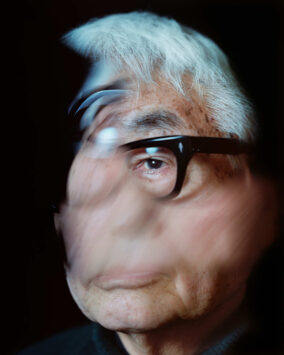Bishin Jumonji
Photographer
Went freelance in 1971. His debut work “Untitled” (no heads) was invited to display in the “New Japanese Photography” exhibit at the New York Museum of Modern Art (MoMA) in 1974.
Throughout his career he has tried to broaden the image of photography by delving deep into the memories and psyche of the viewer.
Many of his works in the 70’s used the motif of people who were close to him or of his dreams and memories. Works such as “Kingan Ryokō” Myopia Travels, where he took his glasses off and photographed with his naked eye and “Good Bye” which used the theme of the last scenery a suicider will see are of this period.
The 80’s sees his subject matter transfer from “personal memories” to “humans”. Produces his masterpiece “Ran no Fune” Orchard Boat depicting first-generation Japanese immigrants to Hawaii.
Received the Ina Nobuo award (1981) for his photo book of the same title.
His “Sumitōtta Yami” Darkness Becoming Visible (1987) in which he documented the Yao tribe of the northern mountainous region of Indochina with photographs and essays is a unique world that cannot be contained in the genre of photography alone.
From the late 80’s and into the 90’s his interests shift to Japanese culture and Japanese esthetics. After shooting Ogata Kourin’s “Senmenharimaze Tebako”, finds interest in the golded art of Japan and published his work “Ōgon Fūtenjin” (1990), wining him the Domon Ken award.
He vigorously persued Japanese traditional architecture and gardens and produced “Nihon Meikenchiku Shashinsenshu 19 Katsurarikyu” Katsura Imperial Villa (1993)
He also started to produce 3D photo books such as “Poketto ni Butsuzo No.1” A Pocket full of Buddhist Statues No 1 and “Poketto ni Butsuzo No 2” A Pocket full of Buddhist Statues No 2 in the same year.
In the year 2000 his focus changed from the golden culture to the complete opposite aesthetics of wabi. 2002 sees the publication of his works, “Wabi” in which he expresses visually how Japanese nature, the art of tea are unbroken and connected to, and leading to the concept of modern day “wabi”.
He also announced works such as “Omokage” Vestiges, “Futatabi Kage” Darkness Again, “Kaza no Gotoku” As The Wind that elaborated on the theme of wabi.
His most recent work is “Kansei no Bakemono ni Naritai” Beyond the Senses (2007), a collection of unpublished work from the 70’s to the present day. He receives the artist award from the Photographic Society of Japan for his photographic activity over the years including this recent work.
In 2007 he publishes works “Sakura” Cherry Blossom and “Owara Kaze no Bon” Owara, Bon of the Wind, in which he fully utilizes single-lens reflex digital camera video features. Becomes the first filmmaker to use digital single-lens reflex camera.
September 2009 he announces his work “FACES” in which he uses a special attachment at the time of shooting to obtain multiple exposures for his piece.
Not a photo that captures the moment but one taken over time to create a single face.
2010, fascinated by the withering structure and color of flowers, publishes “Shinden” Sanctuary.
2013, Publishes “Zanketsu” Missing Peice that focuses on the dismantled section of a Buddha sculpture which was produced in the 13th century. He revives the raw vitality of 700 years ago into the modern world.
[ Chronology ]

Recent Comments